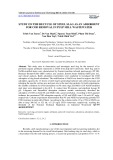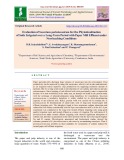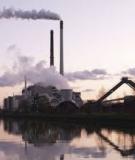
Pulp mill wastewater
-
This study aims to characterize and investigate steel slag for the removal of its persistent organic pollutants (measured as COD) from pulp mill wastewater. Steel slag and its NaOH-modified states were characterized by Fourier-transform infrared spectroscopy (FT-IR), Brunauer-Emmett-Teller (BET) surface area analysis, Barrett-Joyner-Halenda (BJH) pore size, and volume analysis.
 16p
16p  vidudley
vidudley
 20-02-2023
20-02-2023
 5
5
 2
2
 Download
Download
-
Paper and pulp mills discharge large volumes of wastewater into the environment. Crop productivity can be improved by using this wastewater, which is rich in salts and nutrients, as an irrigation source improves crop productivity by supplying enormous amount of nutrients. But for a long termit leads to development of soil salinity and sodicity and also calcareousness.
 14p
14p  nguaconbaynhay4
nguaconbaynhay4
 22-03-2020
22-03-2020
 15
15
 1
1
 Download
Download
-
However, China’s industry is dependent on non-wood fibers (largely agricultural residues) at a 3:1 ratio over wood fiber. This suggests a concentration of many smaller operations. In fact, China’s rapid agricultural growth since 1978 provided fiber for eight-fold growth in the production of smaller papermills between 1984 and 1992 (CTAPI (1993)). The smaller mills have been rapid innovators, but they remain especially environmentally intrusive. They are dependent on pollution control technologies that are not as effective for non-wood fibers.
 98p
98p  loixinloi
loixinloi
 08-05-2013
08-05-2013
 81
81
 13
13
 Download
Download
-
Alberta Environment (AENV), as the systems coordinator for environmental outcomes, will be required to develop environmental policy and standards that support outcomes for the environment and maintain a delivery role for certain activities and sectors. Alberta Environment will collaborate with many departments to integrate the variety of policies and roles that contribute to environmental outcomes. This includes ministries, boards and agencies that regulate activities that affect the environment (e.g.
 30p
30p  loixinloi
loixinloi
 08-05-2013
08-05-2013
 70
70
 2
2
 Download
Download
-
The extent of pollution and toxicity depends upon the raw material used, pulping method, and pulp bleaching process adapted by the pulp and paper mills. For example, the pollution load from hardwood is lower than softwood. On the other hand, the spent liquor generated from pulping of nonwood fiber has a high silica content. Volumes of wastewater discharged may vary from near zero to 400 m3 per ton of pulp depending on the raw material used, manufacturing process, and size of the mill [6].
 133p
133p  loixinloi
loixinloi
 08-05-2013
08-05-2013
 53
53
 6
6
 Download
Download
-
The review of other jurisdictions indicated that there was no jurisdiction that regulated pulp mills for colour on a technology basis. Available literature indicates application of the BATEA outlined in section 3.0 to minimize BOD and AOX releases will also result in minimization of colour to 50 kg/ADt or less. However, Alberta Environment requires colour standards for any newly constructed pulp and paper mill until the mill can demonstrate consistent wastewater colour levels below the colour standards.
 43p
43p  loixinloi
loixinloi
 08-05-2013
08-05-2013
 42
42
 4
4
 Download
Download
-
Technology-based standards are designed to facilitate the use of known, effective, demonstrated pollution prevention and control technologies. The release standards for new and existing pulp mills in Alberta were adopted after evaluation of technologies and wastewater treatment systems for Alberta pulp and paper mills, and top performing mills throughout the United States and Europe (see Appendix 1). The data for European mills are performance expectations and do not represent the regulatory standards that may be applied.
 47p
47p  loixinloi
loixinloi
 08-05-2013
08-05-2013
 49
49
 2
2
 Download
Download
CHỦ ĐỀ BẠN MUỐN TÌM



















